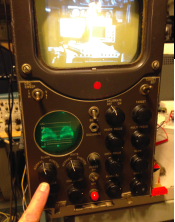NAB Booth #L2
Tom Sprague and Paul Beck have been a part of a handful of Television Broadcast pioneers, mostly engineers, who have developed and maintain The Museum of Broadcast Technology (MBT). This year you’ll find them at NAB in Las Vegas, in the Lobby just outside the North Hall lovingly explaining how we got the picture on our TVs in the early days. It’s with pride they show-off working prized 100% American made pieces of equipment from the 1950s! Operative word is “working.”
 This year they are exhibiting the latest in Television field acquisition equipment for 1952. If you are old enough to remember, that would be the RCA TK-31 (the field version of TK-11). According to Tom Sprague, Chief Engineer at National Boston, “We hope to have two of them making pictures, not great pictures, but pictures none the less. Prior to this time Television was live and immediate, leaving a permanent record only in the minds of the viewers. Sixty years ago that all changed!
This year they are exhibiting the latest in Television field acquisition equipment for 1952. If you are old enough to remember, that would be the RCA TK-31 (the field version of TK-11). According to Tom Sprague, Chief Engineer at National Boston, “We hope to have two of them making pictures, not great pictures, but pictures none the less. Prior to this time Television was live and immediate, leaving a permanent record only in the minds of the viewers. Sixty years ago that all changed!
In 1956; in twin events, one in Chicago at the predecessor of the modern NAB Convention, and one in Redwood City, California; Ampex Corporation introduced to the world a practical means of recording television signals on magnetic tape. They called their new product Videotape!
At NAB you will have to be patient if you want to see these old treasures as you won’t be able to get close to this booth ninety percent of the time. And while sentimental sadness and nostalgia may be among the emotions evoked by a visit to the MBT Booth, so too is a profound sense of historical pride
in its technological significance. It was this equipment, and the people who used it, which precipitated the communications revolution, that is the very thing that, ironically, supplanted the industrial age. Their museum in Woonsocket, Rhode Island is about as good a place as any to see how,
and why, the world changed. “And, that,” says Tom Sprague, “sums up the very purpose of the MBT.”
It’s a salient and poignant point. Of necessity, the MBT commemorates not just broadcasting equipment, but the lost day of American technological and industrial dominance. Back then made in America was
stamped on every piece of equipment you would find in a network or local television station.
The Museum of Broadcast Technology is not supported by any government grants. It’s a public charity. It receives moderate donations, mostly from people who have a connection to the industry or corporations that are still involved in the industry.
Ideally, several modern day giant high tech companies, standing on the shoulders of television’s early engineering and manufacturing feats and dancing on the decks of RCA TK-11 and TK-31 would step up and underwrite the Museum’s efforts for educating future generations about their noble past.
For more information visit: www.wmbt.org



